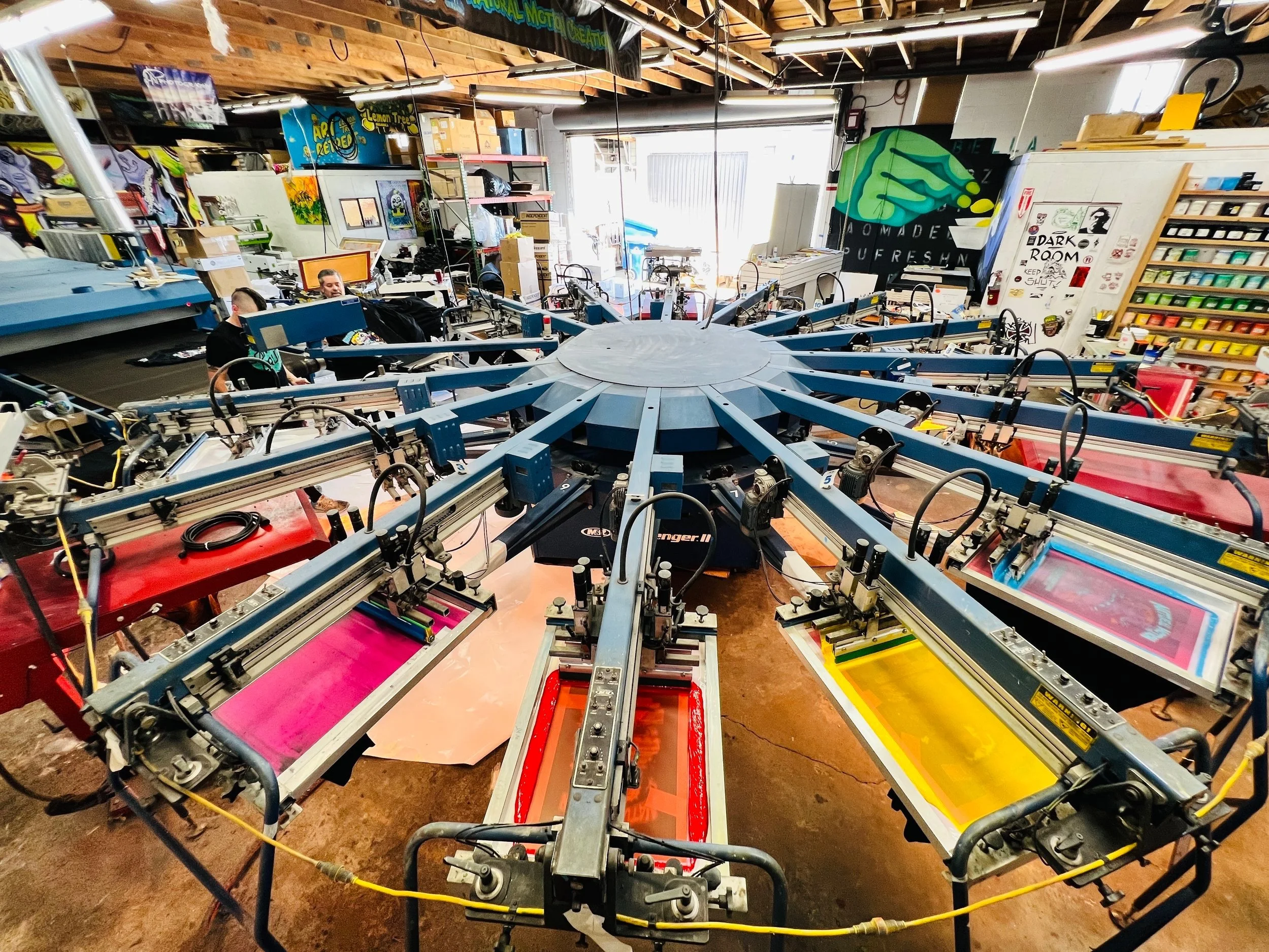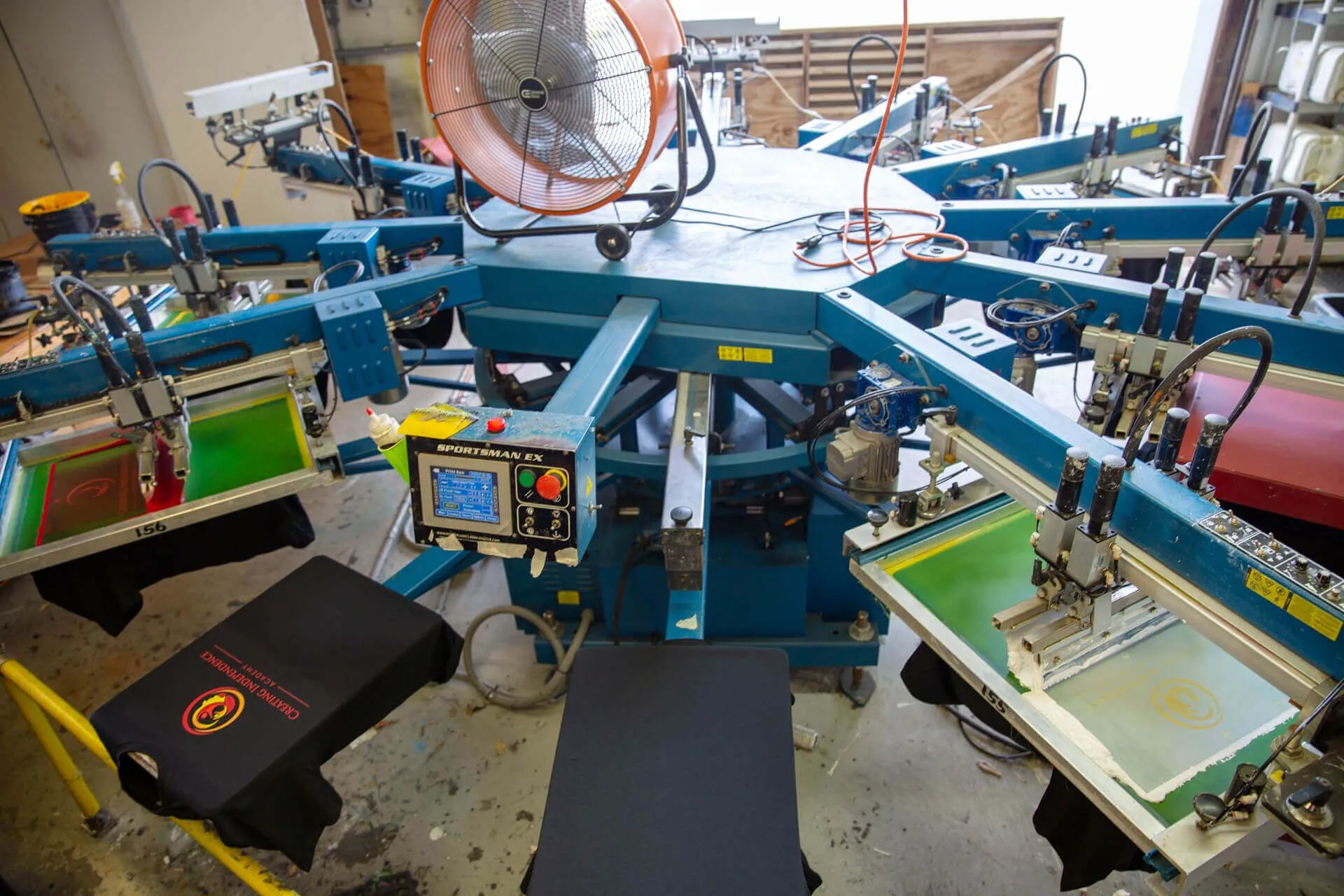Vintage Style Silk Screen Printing for Retro Fashion
Vintage Style Silk Screen Printing for Retro Fashion
Blog Article
Screen Printing Uncovered: Every Little Thing You Required to Understand About Tee Shirt and Garment Printing Methods
Display printing is a fascinating technique that integrates art with technique, providing endless possibilities for creativity. Prepared to discover the essential components that make display printing an art form?
The Basics of Display Printing: Just How It Functions
When you plunge right into screen printing, you'll uncover it's both an art and a scientific research. At its core, display printing includes producing a pattern, or screen, that allows ink to go through just in details areas (screen printing kit). You start by picking your style and preparing your screen with a light-sensitive emulsion. When you subject this emulsion to light, it sets, leaving your design as an adverse room.
Position the display over the material, then make use of a squeegee to press ink with the display onto the garment. Each step is necessary, and grasping them will raise your screen printing abilities, transforming easy garments right into distinct, meaningful pieces.
Kinds Of Display Printing Techniques
As soon as you realize the basics of screen printing, it's time to explore the various strategies that can boost your layouts. One prominent approach is typical screen printing, where ink is pushed through a stenciled display.
One more alternative is plastisol printing, recognized for its longevity and vivid colors, making it a favored for several brands. Experiment with halftone printing to develop slope results and detailed styles.
Important Tools for Screen Printing
To achieve sensational outcomes in display printing, having the ideal tools is basic. You'll require a strong display printing frame, which holds the mesh that transfers your design onto the garment. Next, invest in high-grade mops; these are crucial for using ink equally across the screen.
Choosing the Right Inks and Materials
When picking inks and products for screen printing, you require to consider the kind of ink that functions ideal for your task. Think of material compatibility to ensure your layouts look last and terrific long. Also, explore environment-friendly ink choices to make your printing process more sustainable.
Types of Screen Inks
Picking the appropriate screen ink is necessary for accomplishing lively, sturdy prints that satisfy your project's demands. There are a number of kinds of display inks to examine. Plastisol ink is preferred for its adaptability and convenience of usage, offering excellent shade opacity on dark materials. Water-based ink, on the other hand, offers a softer feeling and is environmentally friendly, making it suitable for those looking to lessen their environmental influence. Discharge inks remove color from the fabric, causing a soft, vintage look but need specific handling. Specialty inks, such as metallic or glow-in-the-dark, can add special impacts to your layouts. Evaluate your job needs and pick the ink that lines up ideal with your desired result.

Material Compatibility Considerations
Recognizing fabric compatibility is vital for achieving top quality screen prints, especially because different materials respond distinctly to various inks. When choosing inks, consider the textile kind-- cotton, polyester, or blends. For cotton, water-based inks work well, using softness and breathability. Polyester, on the various other hand, often calls for plastisol inks for far better attachment and lively colors. You may need to make use of a combination of both types if you're publishing on blends. Constantly examine your inks on example fabric to assure they adhere effectively and maintain shade stability. Furthermore, bear in mind that material weight and texture can influence the final end result, so picking the appropriate ink and product combo is crucial for your project's success.
Eco-Friendly Ink Options
Environment-friendly inks are becoming a prominent option for display printers who wish to decrease their environmental impact while preserving high quality. When picking inks, consider water-based inks, which are much less dangerous and easier to tidy up contrasted to traditional solvents. These inks bond well with textiles, delivering dynamic outcomes without poisonous chemicals. You could additionally explore eco-solvent inks that use fewer unstable natural compounds (VOCs), making them a much safer choice for both your wellness and the earth.
Furthermore, search for inks made from renewable energies, such as soy or vegetable-based choices. By picking the appropriate inks and products, you'll not just develop stunning designs yet additionally add to an extra lasting printing process. Make the switch, and your prints will mirror your dedication to the setting!
Preparing Your Style for Screen Printing

File Layout Requirements
To assure your design looks dynamic and sharp on textile, you'll need to pay close attention to submit layout demands for screen printing. Beginning with vector data like AI or EPS, as they can be scaled without shedding quality. If you utilize raster photos, choose high-resolution data, such as TIFF or PNG, ideally at 300 DPI. Prevent making use of JPEGs, as they can shed clearness when resized. Make certain your design has a transparent history to stop undesirable white edges on your prints. Lastly, keep color settings in mind; CMYK is common for screen printing, why not check here so convert your RGB develops accordingly. By following these standards, you'll establish your artwork up for a successful print.
Color Separation Techniques
Color separation is a vital action in preparing your design for display printing, and mastering it can substantially enhance your print top quality. You'll need to damage your style right into individual colors, as each shade needs a separate display during printing. Start by determining all the colors in your design and develop layers each. You can use software application like Adobe Photoshop or Illustrator to separate and different colors efficiently. Be specific to conserve each layer as a different data, generally in a format like TIFF or PSD. This precision not only guarantees exact color representation however also simplifies the printing process. By taking notice of shade separation, you'll achieve specialist and lively lead to your screen-printed garments.
Resolution and Size
Achieving the finest cause screen printing starts with guaranteeing your style has the best resolution and dimension. Ideally, your art work must be at the very least 300 DPI (dots per inch) for sharp, clear prints. If you make use of lower resolution, your last item might look unprofessional and pixelated.
When it involves size, take into consideration the measurements of your print location. Design your artwork to match the last print dimension, ideally producing it in the real measurements you'll be printing. This method, you'll stay clear of any unforeseen scaling concerns.
Always inspect your design in both vector and raster styles. Vector graphics can be scaled without shedding top quality, making them suitable for screen printing. Preparing properly will assure your design looks impressive on every garment!
Step-by-Step Screen Printing Process
Display printing is a vibrant procedure that permits you to develop vivid layouts on numerous surface areas. To get begun, you'll need a screen, emulsion, and your chosen ink.
Put check this site out ink onto the screen and use a squeegee to press the ink through the stencil onto the textile. Raise the screen thoroughly and let the print completely dry. You have actually effectively screen published your design.
Tips for Successful Screen Printing Projects
While you're diving into your display printing tasks, keep in mind that preparation is essential to success. Start by collecting all your materials-- inks, displays, garments, and squeegees. A clean work space assists stop unwanted errors, so clean up before you start.
Following, verify your art work is high-resolution and correctly sized for your garment. Test your display for appropriate exposure and tidy it thoroughly to prevent spots. When mixing your inks, adhere to the maker's standards to accomplish the appropriate uniformity.
During printing, use even pressure with your squeegee for regular results. Don't rush; take your time to validate each print meets your criteria. After printing, let your garments dry completely before taking care of or packaging them.
Finally, constantly keep an example of your help future recommendation. This means, you can assess your progression and improve your strategies over time. Pleased printing!

Frequently Asked Concerns
How much time Does It Take to Set up a Screen Printing Job?
Setting up a display printing work normally takes about 30 minutes to an hour. You'll prepare the screens, mix inks, and adjust the press. The time varies based upon intricacy and experience, so remain organized!
Can I Print on Various Material Enters Utilizing the Same Technique?
Yes, you can print on various material types using the very same technique, yet you'll require to change your settings and inks. Some fabrics take in ink in a different way, so trying out assurances the finest results for every material.
What Prevail Blunders to Avoid in Screen Printing?
When display printing, stay clear of usual mistakes like making use of the incorrect ink, overlooking correct exposure times, or missing pre-press checks. Constantly evaluate your configuration and preserve tidy displays to guarantee high quality results each time.
Exactly How Can I Appropriately Clean and Keep My Display Printing Equipment?
To correctly tidy and keep your display printing tools, you should regularly wash screens with suitable solvents, check squeegees for wear, and guarantee all tools are kept dust-free and completely dry. Uniformity avoids expensive repair services and boosts efficiency.
Is Display Printing Eco Friendly Contrasted to Various Other Approaches?
Screen printing can be a lot more eco-friendly than other techniques, especially if you use eco-conscious products and water-based inks. By selecting lasting products and practices, you reduce waste and minimize your effect on the earth.
Screen Printing Uncovered: Whatever You Required to Know Concerning Tee Shirt and Garment read this post here Printing Methods
At its core, screen printing entails creating a pattern, or screen, that allows ink to pass via just in certain areas. Setting the display over the fabric, after that make use of a squeegee to press ink via the screen onto the garment. One prominent approach is standard display printing, where ink is pushed through a stenciled display.When choosing inks and materials for screen printing, you need to take right into account the kind of ink that works ideal for your task.
Report this page